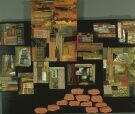![]()
Building Community Series
For four years I have been painting the unfolding history of my homeland, South Africa. My inspiration has been the work of the Truth and Reconciliation Commission (TRC) established in 1995 under the Chairmanship of Archbishop Desmond Tutu to examine the crimes perpetrated under apartheid between 1960 - 1994. The mandate of the TRC was not only to examine South Africa's past but to begin the process of national healing and reconciliation and thereby serve as a catalyst for peaceful coexistence under majority rule.
I conceived the paintings as a work-in-progress to be exhibited as I completed each separate aspect.
 |
 |
 |
 |
| Exhibition I:
Apartheid |
Exhibition II:
Impact on Women and Children
|
Exhibition III:
Institutional Arrangements
|
Exhibition IV: Truth and Reconciliation |
In this Special Exhibits section of the website you can find each of these four exhibits in their entirety. They are organized as follows:
| an introduction and artist statement | |
| thumbnail images | |
|
enlargements of each artwork
along with the text that accompanied the |
I - Apartheid - The legal and geographic framework of apartheid South Africa and human rights violations - exhibited February 2000 at the Langston Hughes Cultural Arts Center, Seattle.
Apartheid deals with the foundations and layout of Apartheid and featured some of the individual stories associated with life under this regime. The artwork described some of the Apartheid's legal infrastructure and how every aspect of South African society was segregated, divided and defined by racial groupings.
Introduction to Series 1: Apartheid
II - The Impact on Women and Children - exhibited May 2000 at Seattle University, Patricia Wismer Women’s Center.
This exhibition focused specifically on the role of women in this process of collective dialogue and reconciliation. The work explored issues of connection, individual strength and group powerlessness.
Introduction to Series 2: Impact on Women and Children
III - The Institutional Arrangements - exhibited
November 2002 at Seattle Pacific University, Art Center Gallery.
Nine paintings address the social context of apartheid, the institutions and the philosophical and cultural milieu in which apartheid thrived. These paintings address the behavior of the collective as opposed to the individual which tends to be the focus of the first two exhibits.
Introduction to Series III: Institutional Arrangements
IV - The Concepts of Truth, Justice and Reconciliation - exhibited
November 2002 at Seattle Pacific University, Art Center Gallery.
In this final phase, eleven paintings explore the processes of seeking truth and striving towards justice and reconciliation. Since these are abstract concepts the paintings utilize shapes, color, texture and writing to evoke and explore these ideas.
Introduction
to Series IV: Truth and Reconciliation
Historical Background and the TRC
When South Africa had its first all race democratic election in April
1994, it took a step toward joining the community of democratic nations of
the world. It also took the courageous and virtually unique step to
examine its own violent past, reveal its ugly truths and move forward in a
spirit of healing and reconciliation. The leaders of the new South
Africa realized there would be no future for the country under majority
rule without all its citizens having full knowledge of their violent past.
The Promotion of National Unity and Reconciliation Act was passed
which established the Truth and Reconciliation Commission (TRC) and
mandated it to:
“...investigate and document gross human rights abuses committed
within or outside South Africa in the period 1960-1994.”
“...bring about unity and reconciliation... based on the
principle that reconciliation depends on forgiveness and that forgiveness
can only take place if gross violations of human rights are fully
disclosed.”
The TRC Act referred to:
“... the need for understanding but not for vengeance, a need for
reparation but not retaliation, a need for Ubuntu (an African principle
that every community member is responsible for every other member) but not
for victimisation”.
The TRC Act provided for three committees to deal with different
facets of the process:
|
The Human Rights Violations Committee to investigate human rights abuses and hold hearings throughout the country. The hearings are not conducted in a court of law; the Committee has no sentencing powers. |
|
The Amnesty Committee to grant amnesty according to criteria set out in the Act; and, |
|
The Reparations and Rehabilitation Committee to make
recommendations to the government on compensating victims and communities
for wrongs suffered in the past. |
![]()